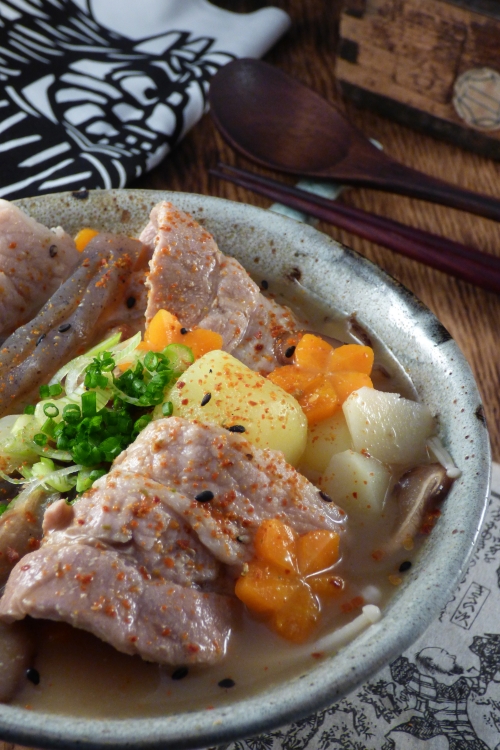When you mention Japanese soup, the dish that springs to mind instantly is the timeless, classic miso soup with tofu and wakame seaweed; in the colder months of the year however, and particularly on the pork-loving island of Kyushu, another soup reigns as king- Tonjiru. Sometimes called Butajiru, both names literally meaning pork soup, it is a much heartier affair than the standard bowl of miso; enhanced with strips of braised pork belly, a selection of root vegetables, blocks of springy jelly-like konnyaku and deeply savoury shreds of mushroom, a bowl of this wintery, sustaining soup quickly starts to feel like a meal in itself. Possibly not a soup suited to breakfast time due to its more stew-like consistency, it makes a fantastic accompaniment to both meaty dishes and also beer, and as such it finds its way onto the menus of many izakaya, tonkatsu restaurants and gyudon joints. Outside of restaurants, we’ve found it for sale at religious festivals, farmers’ markets, sporting events and anywhere that large numbers of people gather together and need feeding; a homely classic full of earthy flavours that brings diners together and ignites childhood memories of mothers’ cooking.

Ingredients.
- 300g thinly sliced pork belly
- 1 litre dashi stock
- 4 dried shiitake mushrooms
- 150g carrot
- 200g burdock root
- 250g taro
- 20g piece ginger
- 220g block konnyaku
- 75g miso- we like to use awase miso for tonjiru, but feel free to use your favourite type
- 1 tablespoon sesame oil
- 1 tablespoon vegetable oil
- 2 spring onions, sliced thinly
- shichimi togarashi to serve
- Place the dried shiitake mushrooms in a bowl, pour over enough boiling water to cover and leave them to rehydrate whilst you prepare the rest of the vegetables. Peel the skins off the carrots and taro, then cut the carrot into half-moon slices and the taro into small chunks. Next, scrub the gobo and ‘shave’ into small slivers with a knife (like sharpening a pencil), dropping the cut pieces directly into a bowl of cold water with a splash of rice vinegar to prevent the root oxidising and turning brown. Peel the ginger and chop it into fine shreds. When the mushrooms have plumped up fully, remove them from the soaking water, discard the stems and cut the caps into thin slices.
- Put the sesame and vegetable oils into a large saucepan and allow to warm over a medium heat, then add the thinly sliced pork and chopped ginger, and fry until the pork is opaque but not starting to brown. Pour in the dashi stock, bring the liquid to the boil, then turn the heat down and leave the pork to simmer for thirty minutes.
- After this time, add the carrot, taro, burdock and mushrooms and cook for a further fifteen minutes. Whilst the vegetables are simmering, cut or tear the konnyaku into small pieces, rinse them under boiling water to remove any unpleasant odour then add into the broth and cook for another five minutes.
- When all the vegetables are tender, turn off the heat under the pan. Put the miso paste into a small bowl then add a ladleful of hot broth and stir to dissolve the miso completely; pour the loosened miso back into the pan of tonjiru and mix well to make sure the miso is evenly distributed.
- Divide the soup between four bowls and top each portion with sliced spring onion and a sprinkle of shichimi togarashi powder, serving extra on the side for people who like it particularly spicy.
Serves 4 people.
Do you ever make Seitan? I’m trying to make a ‘white’ version but can’t find Shiro Shoyu in UK.
Have been using Tamari Kombu Dashi for the broth thus far.
LikeLiked by 1 person
Hi Paul, we’ve tried a few different seitan recipes over the years but have never made one that turned out particularly pale, even using shiro shoyu will still give quite a dark finish as the sauce isn’t actually as white as its name suggests. The main brand we’ve been able to get in the UK. is Yamashin, which is usually available from the Japan Centre in London (although they appear to be out of stock at the moment). Happy hunting though, and if you do manage to find a truly white shiro shoyu, please let us know 🙂
LikeLike
How about sweet white Shiro Miso?
LikeLike